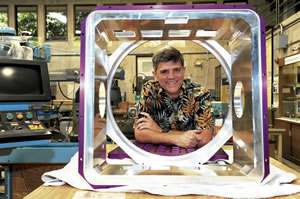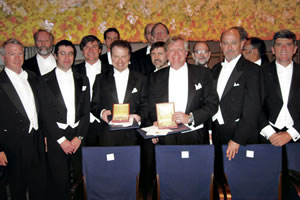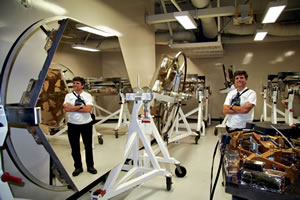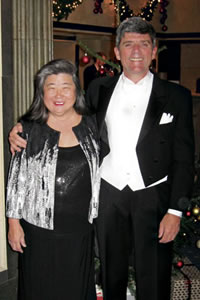Killer Asteroids and Einstein’s Blunder

John Tonry with body parts of his gigapixel camera named Barney. Photo by Nathalie Walker, nwalker@midweek.com
A beach ball of the globe hangs from the ceiling, so does a toy pterodactyl. By the doorways are comics and snippets of jokes that fly over the heads of most earth-bound humanoids, and on the walls are posters of gorgeous, swirling star-speckled galaxies that make the imagination salivate.
This is the University of Hawaii’s Institute for Astronomy (IfA) and, in the lab, amid myriad lenses, wires, tools, workstations, and sitting next to a guy whose shirt reads, “talk nerdy to me,” is John Tonry, who builds cameras. Not any old camera … Incredible Hulk-sized gigapixel (1 billion pixels) machines with shutters 4 feet wide that can capture images of stars in the farthest reaches of outer space. But MidWeek is speaking with Tonry today for a separate project, one that won his team’s leaders the 2011 Nobel Prize in physics.
“I never ever would have guessed that I’d end up in astronomy,” says the astro-physicist who answers to the more modest title of
astronomer. He came to astronomy by way of physics, obtaining a math degree at Princeton before entering Harvard to major in physics and rising to the rank of full professor at the MIT physics department. Yet, even as a child, a spark for cosmological research was smoldering in the young boy’s mind.

John Tonry (far right) with the High-Z Supernova Search Team. Accepting the Nobel medals are team leaders Adam Riess (left) and Brian Schmidt. Photo courtesy of John Tonry
“I was given a telescope by my grandparents when I was very young, and I really wanted to find the planet Mars because I was sure the invaders came from Mars. And I didn’t know how to use it, so I would point the telescope at any red thing I could see in the sky and defocus it so that it would go to a big, blurry disc and I would imagine that was the planet Mars.”
Fast-forward several years and as a Ph.D. student embarking on his thesis, a cohort’s astronomy thesis catches Tonry’s interest, again that cosmology spark is kindled. Fast-forward a few more years and the New Hampshire native is at MIT feeling a bit “stale,” and where does anyone go to find their mojo? They head West, of course. And that’s how he arrived at IfA.
“Throughout my career at MIT I’d been very interested in cosmology and expansion of the universe, and how fast is it expanding and what’s the eventual fate of the universe,” says Tonry. “One of the advantages of Hawaii is Mauna Kea and the big telescope. Plus, CCD detectors (digital detectors) were getting so big and capable – I mean, megapixels and megapixels – and also computer power was getting so advanced that you could actually process all that information, that it opened the door to new ways of doing astronomy. I thought, I want to be on the leading edge of that.”
And he was … to the tune of the Nobel Prize. He was on one of two competing teams that set out to determine the fate of the universe, and with this perfect storm of experts and technological advancement, they discovered something that had even fazed Einstein a century prior.“Einstein called this his biggest blunder,” says Tonry. “It was something he realized was compatible with general relativity, but for him it seemed so inelegant he said forget it, but it turned out actually that’s sort of what’s going on.”
Expounding on the topic, Tonry relays in kindergarten terms (for an infinitesimally lesser mind) that if you throw something up, it must come down, unless you throw it faster than the escape velocity, in which case it leaves Earth and never comes back. It’s the same case with the universe. A popular theory posited that the universe will continue expanding until it begins decelerating and will turn in on itself and recollapse. However, it was also possible that it would expand forever, as suggested by a theory about the cause of the Big Bang called “inflation.”
With a team of 15 scientists from around the globe, Tonry, the sole IfA addition, spent 1994-2001 looking through a telescope, recording his findings, compiling the results and laboriously rechecking those results, in an attempt to answer big questions about the fate of the universe. His search was for a particular type of supernova, an exploding star. When they explode, a standard unit of energy is released, meaning that if it explodes brightly, the star is relatively close, and a dim explosion means it is farther away.
“If we can find this particular type of explosion, we can essentially map out the universe – we know exactly how far away the explosion is and in addition we can measure how fast it’s going. That means that we’re measuring the speed of the universe at a signpost out there in space,” explains the UH professor. “But remember, there’s this light travel time, so not only is it far away in space, it’s way back in time.”

Tonry in a lab on Mauna Kea amid parts of the 10m Keck telescope that sits at the summit. Segments of the telescope, which is comprised of 36 hexagonal mirrors tiled together to make a single, huge imager, are periodically removed and brought to the lab for cleaning and realuminizing. Photo courtesy of John Tonry
Tonry is referring to light years, essentially, the distance light travels in one year, so that when he spots supernovae far off in the galaxy, he is looking at stars that exploded even billions of years ago: “It’s like a time machine, where you can look back into the universe’s history and find out how fast it was expanding in the past.”
By mapping out these stars and comparing the rate of expansion in distant galaxies to nearby galaxies, the team discovered that the inflation theory was correct, but with a twist: The universe is actually expanding faster now than it was in the past. And this prizewinning discovery was where Einstein’s blundering “cosmological constant” seems to be realized as something now termed “dark energy,” which works by pulling everything apart instead of pulling together like normal gravity, causing the galaxies to move apart from each other at a faster and faster rate in the speeding up of universal expansion.
The bad news for the universe from Earth’s viewpoint is that as the dark energy causes galaxies to recede ever faster, and stars in our own galaxy age, “our beautiful, gaudy Milky Way spiral galaxy will get dimmer and dimmer,” notes Tonry. “The fireworks will end. The party will end. The sky out there with all the galaxies will get dimmer and darker and fainter as they move further and further into the night.”
The good news is the universe as we know it won’t move gently into its good night for many billions of years. Furthermore, barring manmade catastrophe, the earth will remain healthy for many hundreds of years thanks to Tonry’s current project scoping out killer asteroids. Statistically, points out Tonry, we’re more likely to die from an asteroid attack than a plane crash. When you consider that asteroid’s impact every couple hundred years decimates populations at an average of 100 people per year, Deep Impact is plausible.
“Because it doesn’t occur in our lifetime, it’s off our radar screen,” says Tonry, “but imagine how bad we’d feel if we got clouted next year and we could have looked. The advantage over looking for hurricanes, earthquakes or tsunamis is that asteroids are really predictable. If we find one, we can tell you within a mile where it’s going to hit and within a few seconds of when it’s going to hit, which means that you can move people out of the way. If you find it early enough, like 100 years before it’s going to hit, you can map out a space mission and actually nudge it a bit so that it misses the earth.”
His current work involves an instrument called PanSTARRS, which searches for killer asteroids, and he’s on the verge of kicking off a project called ATLAS, an asteroid last warning system. But he’s not always behind a telescope or at a computer. He does manage to get outside and look at all the lovely stars with his own naked eyes while camping, and he explores Earth by way of running, hiking, kayaking and lots of traveling, often with his partner Roberta Lee-Driscoll.
Importantly, the man who also happens to have a healthy sense of humor – he’s named his latest giant purple camera Barney (Get it? The purple … ?) – has done Hawaii proud as a key player at a landmark moment in the discussion on cosmology.




